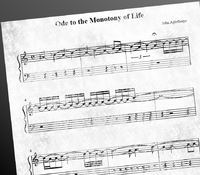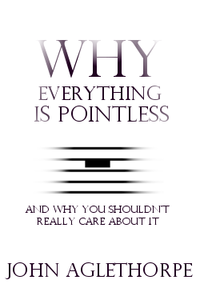Ode to the Monotony of Life
John Aglethorpe's Ode to the Monotony of Life is considered to be the world's longest song at exactly three minutes shy of a full year. The majority of the song is composed of alterations between A sharp and B flat tied together, resulting in what sounds to the untrained ear as one continuous, monotonous tone. Originally composed for the piano, Algethorpe's Monotony has been adapted for over a dozen different instruments, although it is only known to have been played in its entirety once.
Aglethorpe, according to legend, came up with the idea of Monotony when working at the office one day. His computer was humming along as it always did, and just as any other genius would, he pondered what the computer was humming about. About a minute and a half into his pondering, he realized that this question was very stupid indeed. Then, recalling that most incredible ideas came from such humble origins, he decided to roll with it to see if this was, in fact, one of those ideas.
Background
John Aglethorpe was born around 1982 to two delighted parents, and had a very average life without much tragedy. For this reason, no one has bothered to write a biography about him, thinking that it would be too monotonous.

Composition
Aglethorpe composed Monotony by listening very closely to his computer, alone in his cubicle. He jotted down notes and notes and also notes about notes as he stuck his ear flat against the monitor. A mere five and a half months in, he discovered two things. One, the computer seemed to have a liking for the A sharp - B flat range. And two, this task was becoming very boring.
Luckily for Aglethorpe, five years of listening and composing did little harm to his job. Being a tech support person, nearly all customers first had to go through an automated system and, if that failed, a few calls to India. He was only interrupted twice during the composition period, once by an old woman who couldn't seem to locate the power button, and once by a teenager that simply had the wrong number for a pizza place. During these periods of interruption the composer simply sketched a few whole notes on his paper.
The one thousandth measure rest
Exactly one thousand measures in, the tune that has graced over a hundred pages falls silent, replaced by a four-beat rest. This controversial move has stirred music critics and fans alike, often described as "something of a break in the pattern".
Some say that the rest is representative of a sudden pause in the monotony of one's life, when one finally realizes that he or she is trapped in a constant, repeating pattern, the same march day after day, drummed into their head, suffocating their life and stifling their creativity, and realizing, too, that the only true escape is death, which is far too icky to take. According to some, Monotony takes a dramatic turn after the rest, with more A sharps than B flats, supporting this theory. Others see it as more of an optimistic turnaround, where Monotony decides that life is futile, and figures it just has to deal with it.
The truth, however, is far different. In Aglethorpe's upcoming book, Why Everything is Pointless (and Why You Shouldn't Really Care About It), he devotes almost a sixteenth of a chapter to the history of Monotony. Some consider this to be representative of his vast usage of sixteenth notes, but Aglethorpe says that he just didn't want to dwell on it too much, and that mathematicians seriously need to find something better to do.
| “ | ...one fine day at my workplace we had a power outage, which somewhat broke the monotony of the whole thing; my computer, my source of inspiration, was down; and so I decided, in honor of the brief silence, to place a rest in my piece; I expected the rest to be somewhat controversial, as it seemed to shatter the illusion of monotony, but I figured I'd bored the audience enough by this time, and I needed something to really surprise them; and so I colored in the little block on the next line, crudely drawn, along with the rest, on a sheet of paper, finished the page, and placed it atop my rapidly growing pile, waiting for the power outage to cease; and then I went on from there... | ” |
It is somewhat interesting to note that Everything is Pointless does not, in fact, have any periods in it. Some have argued that Aglethorpe was trying to make a point while doing this, and upon hearing this, Aglethorpe had to be hospitalized for having too much irony in his bloodstream.

Performance
Monotony has been adapted to suit instruments such as harmonicas, tubas, bagpipes, and even spoons. At times the note range has been adjusted to better suit the instrument in question, yet still keep with the composer's original intent. Despite over six copies being sold, the piece has only known one true performance.
The lucky man who played through a year's worth of notes and a forest worth of paper was later discovered to have died soon after hitting the first note — an A sharp — yet through some miracle and some rigor mortis managed to bang out the entire piece. Neighbors came to check in on him from time to time without realizing his fatal condition, mistaking it for dedication and determination to be the first to finish Monotony. And apparently, he was — although Monotony "purists" say he was merely on the fermata in the third measure, and that the song remains impossible to play to this day. It is unknown if the man paused for the Rest.
Controversy
Some critics claim that Monotony is only one note written very fancily with one brief break a thousand measures in. Others say that its beauty is in its simplicity. Still others don't want to get involved in the whole mess, and have taken a vacation until the bickering dies down.
Aglethorpe claims that Monotony is the single longest piece of music ever written, yet The Song That Never Ends theoretically goes to infinity. Furious with this accusation, Aglethorpe took back anything he said about mathematicians and their quality of life, and asked them about this "nonsensical" claim. Math says that Never Ends cannot be longer than Monotony, as infinity is not really a value, but merely an idea that cannot be quantified. And before anyone could say "QED," math was promptly shot in the face for making up such bullshit, setting the subject back several years. Mathematicians are now trying to figure out what two and two is, and have not yet released any further information on the lengths of infinity.
Aglethorpe decided not to argue the point further, as this would contradict his philosophy. Instead, rumor has it that he is hard at work finishing his pointless autobiography and his first film, each frame of which includes a color of the color wheel in the darkest shade possible.
Several cryptographers have attributed the complexity of Monotony to the idea that there is a code hidden inside the score. Having run all of the pages through several dozen tests and procedures, they have produced nothing of interest, other than what they believe to be the word "BANANA" cleverly encrypted in several of the pages when they carefully shoved in a few N's. A few more radical cryptographers are seeking the original score for any mysterious patterns, including a few brown-colored arcs on several pages that, according to theory, if certain pages are laid atop one another in just the right order, form a complete circular symbol.
Some claim that Aglethorpe made these intricate patterns merely from the bottom of his coffee mug, and that the shape formed is not a mere accident, but rather, a symbol of life. This symbol is no more than the common circle, coming back together again, looping around and around with no end, the perfect picture of monotony.
| Featured version: 29 August 2007 | |
| This article has been featured on the main page. — You can vote for or nominate your favourite articles at Uncyclopedia:VFH. | |



